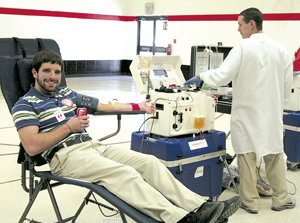ROLLING UP SLEEVES AND SAVING LIVES
 Ian Kohrman loves saving lives.
Ian Kohrman loves saving lives.
Lucky for Ian, he gets to play a role in saving hundreds of lives every day, currently 50-60 hours a week.
Ian works for the American Red Cross in the Fort Wayne area, and he and his staff of about eight others were helping Waynedale residents save lives.
Since January is National Blood Donor Month and the message last Sunday from Father Dave was, “available blood is low and at an emergency state” and, via the church sign on Lower Huntington Road, St. Therese parishioners and Waynedale residents were encouraged to roll up their sleeves…and give blood.
“January is an absolutely perfect time of year to honor blood donors and all they do to help save lives,” said Sharyn Whitman, CEO for the Indiana-Ohio Blood Services Region of the American Red Cross.
Since 1970, blood collection organizations like the American Red Cross have designated January as National Blood Donor Month. Each year, about 9.5 million volunteers donate around 16 million units of whole blood and red blood cells. About 20 percent of these donors give blood for the first time.
Every reason is unique when you give blood, as this Waynedale News reporter found out through interviews with a few of the blood donors.
At St. Therese, blood donors gave “to do a good deed and to help someone out” and “…in memory…to a loved one that they lost.”
“I’m giving blood today because it’s a good thing to do and supports the community,” said third time donor Sue Bonahoom.
And for some it was their first time to the blood drive and a way to thank God for the good health that they had been given.
A Luers high school student said, “I gave because someone else needs it more than I do.”
To begin the process of donating blood you sign in and are asked a few basic questions, including medical history (all information given is confidential). You need to provide a form of ID or your donor card and then a mini-physical is given checking your temperature, pulse, blood pressure and hemoglobin level making sure that it is safe for you to donate. During the actual donation process, which takes about 10 minutes, you sit comfortably and if you have any concerns a Red Cross staff member is available to answer your questions. After donating, you are invited to have a snack and/or something to drink before leaving. The entire process, from arrival to leaving, takes about an hour and 15 minutes, if you are donating whole blood.
Typically, when a blood donor makes the decision to donate, they give whole blood.
A few donors were fortunate enough to be able to donate double red blood cells, including Daniel Davis, a seminarian for the Diocese of Fort Wayne-South Bend at St. Therese Catholic Church.
Donors, like Daniel, must not only meet the guidelines for donating whole blood: at least 17 years old, weigh more than 110 pounds and be in good health, but in addition, male donors must be a minimum of 5’1” tall and weigh 130 pounds and female donors must be at least 5’5” tall and weigh 150 pounds. They must also wait about four months between double red blood cell donations.
Double red cell donation is similar to whole blood donation, except a special machine is used to donate two units of red blood cells at one donation and at the same time your plasma and platelets are given back to you, along with some saline. According to the American Red Cross, red blood cells are the most frequently used blood component and are needed by almost every type of patient requiring transfusion. The donation procedure for red blood cells takes about 20-30 minutes longer than a whole blood donation.
“Blood donors play a vital role in modern health care,” said Whitman. ”Hospitals need blood daily for the treatment of serious diseases and conditions, for emergency care, and for lifesaving surgeries.”
Every day, about 39,000 pints of blood are transfused in the United States. All blood types are needed. Six times a year you can donate whole blood. And, from that single blood donation you can save 3 lives!
While the need is constant, blood donations often slump during the winter because of cold and snowy weather—making it even more important for donors to give blood if they can.
Whatever the reason was for over 30 Waynedale area residents to give blood on Sunday, January 9, they should feel good about knowing that they helped save someone’s life.
How to Donate Blood
To schedule an appointment or find a location near you to donate please call 1-800-REDCROSS (1-800-733-2767) or visit redcrossblood.org for more information.
- ELMHURST IS COMING DOWN BUT MEMORIES REMAIN - May 25, 2018
- WAYNEDALE ELEMENTARY’S CLUB “O” PRESENTS RECITAL - May 11, 2018
- LEBAMOFF RESERVOIR PARK RESTORED - May 11, 2018

